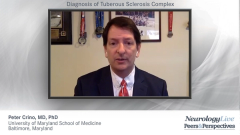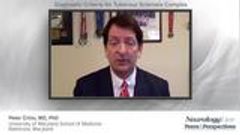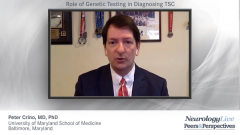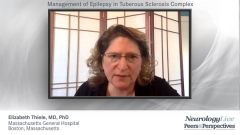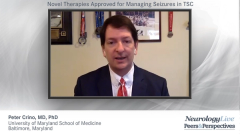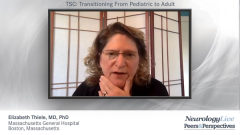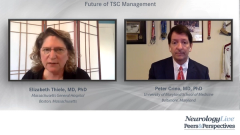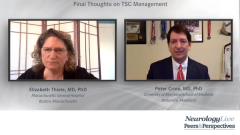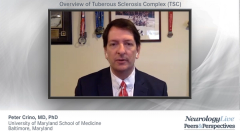
Management of Epilepsy in Tuberous Sclerosis Complex
Peter Crino, MD, PhD, and Elizabeth Thiele, MD, PhD, review the spectrum of epilepsy in patients with TSC and approaching the treatment of seizures.
Episodes in this series

Elizabeth Thiele, MD, PhD: Think about autism in this population. Autism is more frequent in TS [tuberous sclerosis] than other disorders. When we looked at this, up to 40% of people had autism, many highly functioning. It’s still something we look for. Epilepsy has been the focus both for you and me throughout our careers. What drew me to tuberous sclerosis was the infantile spasms. We know that 85% of people with TS will develop seizures. When we looked at this—and other people have looked at this—70% had onset the first year of life, which is clearly what leads to a lot of young children being diagnosed with TS. The thing that drew me to TS was the fact that a third of children with TS will have infantile spasms. We’ve learned a lot about infantile spasms from studying it, particularly the role of vigabatrin in treating infantile spasms and then moving on. What advice do you give patients who come in? Maybe your adolescents? What do you tell them about the natural history? Do they always have epilepsy with TSC [tuberous sclerosis complex]? Are those questions that the parents of young children want to know? Are those questions adolescents want to know? What advice do you give your patients on that?
Peter Crino, MD, PhD: It’s a great question. I usually start with the disclaimer that my crystal ball is officially busted, so I don’t know what the future is going to hold. I see multiple trajectories. One is that basically nothing changes: a pattern of seizures that are recurrent—maybe recalcitrant—to medicines, which may be evaluated for epilepsy surgery. That’s 1 trajectory. The other is that I’ve seen individuals who’ve had modest epilepsy burden when they were younger, and unfortunately their epilepsy got worse as they get into teenage years and then into their 20s. In fairness, I have seen the opposite of that, which is that people had pretty hefty epilepsy burden as children and teens. Then they get to their 20s and 30s, and things quiet down a lot.
I prepare people for the possible trajectory, so they know what’s coming. As a broad observation in the care of patients with TS, as a practitioner, the most important thing you can do is prepare them for all the options, so there are no surprises. That goes a long way, so that people understand, first, why are we doing the test? Why do we get MRIs of the kidneys and of the brain? Why do we look at the lungs? The reason for surveillance is to stay in front of TSC and to always be proactive about it. Prudence would dictate, and the literature would dictate, that if you stay in front of TSC, the outcomes for patients in terms of morbidity is much improved. I try to give people a sense of the landscape, that this is a team effort, it takes a village to get them through this. Things might get worse, but things might also get better. Either way, we’re here no matter which way it goes.
Elizabeth Thiele, MD, PhD: It’s really important. Parents of children or individuals living with TSC need to understand that there’s a spectrum. I completely agree with you about the epilepsy. When we looked at this, about two-thirds of the patients we follow had refractory epilepsy, or seizures that aren’t easily treated or controlled with medication. Even if you look at outcomes with those 40% of our patients—when we looked at this several years ago—they develop remission from their epilepsy, and many were able to come off treatment. I’ve met several people over the years who see me for a second opinion, who come to a TSC center to see what comprehensive care would be like.
When we talk about epilepsy they have often said, “We were told that we would always have epilepsy because we have TSC.” That’s an important message as well, that there’s hope that you might not always need to be on treatment or be worried about seizures. When you think about treating seizures and TSC, we’d all agree that it’s not even disputable that vigabatrin is the first-line drug for treating infantile spasms in tuberous sclerosis complex. We know that seizures in TS are focal. If you look at focal vs generalized epilepsy, we know that it’s a focal epilepsy. How do you approach the treatment of seizures in TSC?
Peter Crino, MD, PhD: Thankfully, we have lots of choices in medications and nonmedical approaches. Within nonmedical approaches, we have surgery, we have neuromodulation, and we have dietary therapy. There are lots of opportunities to make quality of life better. It’s important to define what that quality of life will be. Is it seizure freedom? Is it a reduction in seizures by 50%? The physician’s concept of being seizure-free often isn’t commensurate with what patients want in terms of quality of life. I try to listen and say, “What do you what? What’s the goal here?” I use a pretty general strategy for people with epilepsy by going through standard antiepileptic medications and trying to pick ones that fit with the particular patients. Certain medicines work better in men than in women of childbearing age. Certain adverse-effect profiles work better with other medicines, medication interactions, and other comorbid medical conditions, trying to figure out what might fit best. If they come to the position that they’re indeed medically intractable, that’s to say that they’re still having seizure despite at least 3 medications alone or in combination, then I evaluate them in a very methodical way for the possibility of epilepsy surgery, starting with an admission to the epilepsy monitoring unit. If we need to go the route of considering epilepsy surgery, we either do it after the first phase of evaluation or, in some patients, we need EEG [electroencephalogram]—we need to put electrodes in the brain, and you explain the process to patients.
Elizabeth Thiele, MD, PhD: I’d like to thank the audience for watching this Neurology Live® webinar. If you enjoyed the content, please subscribe to our e-newsletters to receive upcoming programs and other great content right in your in-box.
Transcript Edited for Clarity
Newsletter
Keep your finger on the pulse of neurology—subscribe to NeurologyLive for expert interviews, new data, and breakthrough treatment updates.

